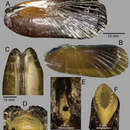Description
provided by Zookeys
(Fig. 5) Calcified shell to 67mm in length, to 85mm including periostracal fringe. Robust. Equivalve. Inequilateral, beaks situated at 1/4 length of shell from posterior margin. Outline subcylindrical, compressed, calcified shell length about 3 times height, slightly deeper towards the anterior, dorsal and ventral margins subparallel, anterior margin more broadly rounded than anterior, posterior dorsal margin projecting a little. Including periostracal fringe, anterior appears greatly expanded compared with posterior. Beaks indistinct, umbos sunken. Hinge teeth absent. Ligament external, as a high arched band posterior of the beaks and supported by a thickened shell margin; an oval area of ligament is present immediately behind the beaks and visible internally, anterior of the beaks shell margins fused by periostracal material along entire dorsal margins. Periostracum persistent and extending well beyond the shell margin, initially yellowish brown in colour but darkening with growth to dark brown and black; periostracal frill thickened over ribs but entire. Sculpture of radial ridges, 4 closely spaced over the posterior; median area almost smooth with 2–3 low ribs; anterior with 8–9 deeply cut ribs. Adductor scars impressed, posterior scar subcircular, anterior adductor scar larger, spatulate in outline. Anterior inner shell margin scalloped corresponding to radial ribs.
Posterior siphonal opening surrounded by a series of papillae (Fig. 5E): A single large dorsal papilla (dp) lies above 2–3 pairs of slightly smaller papillae (dmp) on the dorsal margin of the opening, below these surrounding the opening is a series of approximately alternating large and small papillae with those most ventral the largest.
The mantle edge is fused from the posterior siphon for half the length of the ventral margin where there is a large anterior pedal gape. The mantle edge surrounding the rear of the foot is papillate. The anterior dorsal mantle edge is prominently papillate(Fig. 5D). The foot is very large with a broad oval sole, the margin interdigitates between large and small blunt papillae. The ctenidium is large with numerous laminar filaments attached to a prominent gill axis. The palps are short, twisted and flattened with cup shaped terminations. The presence or absence of a gut could not be confirmed.
- license
- cc-by-3.0
- copyright
- Graham Olive, Clara F. Rodrigues, Marina R. Cunha
- bibliographic citation
- Olive G, Rodrigues C, Cunha M (2011) Chemosymbiotic bivalves from the mud volcanoes of the Gulf of Cadiz, NE Atlantic, with descriptions of new species of Solemyidae, Lucinidae and Vesicomyidae ZooKeys 113: 1–38
- author
- Graham Olive
- author
- Clara F. Rodrigues
- author
- Marina R. Cunha
Distribution
provided by Zookeys
Acharax gadiraeis presently only known from the mud volcano fields in the Gulf of Cadiz, Eastern Atlantic. The specimens have been taken from the Western Moroccan field at Yuma, Ginsburg and Jesus Baraza MVs, and from the deep-water field at Captain Arutyunov, Carlos Ribeiro and Porto MVs at depths between 975 to 3902m. A single specimen was recovered from the shallower El Arraiche field in Pen Duick Escarpment at 556m.
- license
- cc-by-3.0
- copyright
- Graham Olive, Clara F. Rodrigues, Marina R. Cunha
- bibliographic citation
- Olive G, Rodrigues C, Cunha M (2011) Chemosymbiotic bivalves from the mud volcanoes of the Gulf of Cadiz, NE Atlantic, with descriptions of new species of Solemyidae, Lucinidae and Vesicomyidae ZooKeys 113: 1–38
- author
- Graham Olive
- author
- Clara F. Rodrigues
- author
- Marina R. Cunha

